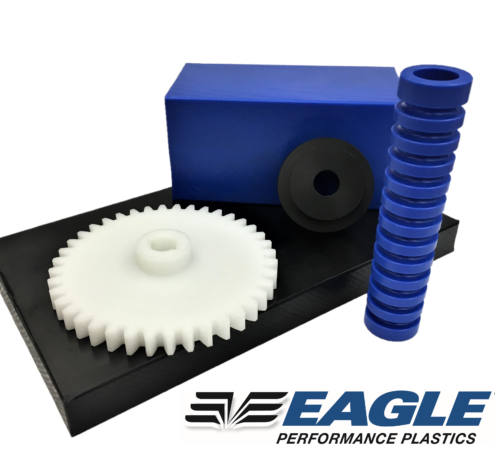PPSU Unfilled

PPSU Unfilled Overview
What is the Material: PPSU Unfilled is an amorphous material.
Key Material Features: This material is beneficial in applications requiring impact resistance, chemical resistance, and hydrolysis/steam resistance.
Other Considerations: This material has more diverse chemical resistance than PSU and PEI.
Physical
| Property | Value | Typical ASTM Test |
|---|---|---|
| Chemical Designation | (PPSU) Polyphenylsulfone | |
| Trade Names (®, ™) | Radel, Tecason P | |
| Color | Black and White | |
| Density (g/cm^3) | 1.29 | D 792 |
Mechanical
| Property | Value | Typical ASTM Test |
|---|---|---|
| Modulus of Elasticity (Tensile Test) (psi) | 340000 | D 638 |
| Tensile Strength at Yield (psi) | 11500 | D 638 |
| Elongation at Break (%) | 60 | D 638 |
| Flexural Strength (psi) | 13200 | D 790 |
| Modulus of Elasticity (Flexural Test) (psi) | 350000 | D 790 |
| Compression Strength: 10% Strain (psi) | 14350 | D 695 |
| Compression Modulus (psi) | 234000 | D 695 |
| Impact Strength (Izod) (ft-lbs/in) | 3 | D 256 |
| Hardness (R) | 123 | D 785 |
| Hardness (M) | 96 | D 785 |
Thermal
| Property | Value | Typical ASTM Test |
|---|---|---|
| Vicat Softening Point (°F) | 424 | |
| Deflection Temperature (°F) (264 psi) | 405 | D 648 |
| Service Temperature Continuous (°F) | 300 | |
| Service Temperature Intermittent (°F) | 360 | |
| Thermal Expansion (CLTE) (in/in/°F) | 3.10E-5 | D 696 |
| Thermal Conductivity (BTU-in/hr-ft^2-°F) | 1.74 | |
| Specific Heat (BTU/lb-°F) | 0.27 |
Electrical
| Property | Value | Typical ASTM Test |
|---|---|---|
| Volume Resistivity (Ω*cm) | 9.00E15 | D 257 |
| Dielectric Strength (V/mil) | 381 | D 149 |
| Dissipation Factor (1MHz) | 0.002 | D 150 |
| Dielectric Constant (1MHz) | 3.44 | D 150 |
| Dielectric Constant (60 Hz and 50% RH) | 3.44 | D 150 |
Other
| Property | Value | Typical ASTM Test |
|---|---|---|
| Moisture Absorption (%) (24 Hours) | 0.37 | D 570 |
| Moisture Absorption (%) (Saturated) | 1.1 | D 570 |
| Flammability | V-0 |
The data stated are typical values intended for reference and comparison purposes only. The data should not be used as a basis for design specifications or quality control. The information is provided as a guide to the best of our knowledge and given without obligation or liability. Testing under individual application circumstances is recommended.
